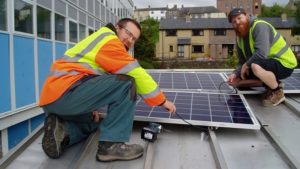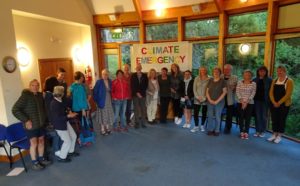How you can take action at a community level for climate change.
Climate change can sometimes feel like an issue that is too big for individuals to make much of an impact on. However, actions by many individuals can add up to a massive positive impact on reducing carbon emissions.
This positive impact can be magnified if an approach to reduce carbon emissions is started at a community level. This section shows approaches taken in different communities to reduce their carbon emissions and reduce their impacts on climate change, recognising that every community is different.
Whether you’re a community group, a parish council, or a group of neighbours concerned about climate change and the environment, the guidance here should help you work out what you can do at a community level.
Sustainability groups in Cumbria
If you’re interested in taking action against climate change in your community a good first step is to check if there’s already a sustainability group in your community. Find out about local groups on the Zero Carbon Cumbria site>
Grant support for community climate action
You may also be able to tap into grant support to help you run climate projects and events in your community. Find out more >


Individual projects or a big vision – what’s the best approach when taking climate action in your community?
When taking action in your community we recommend taking a ‘whole-place’ approach to reducing your area’s carbon footprint.
This means looking at your community’s carbon emissions as a whole and considering up front what you want to achieve overall. This approach tends to be more effective than running ad hoc projects, which are unlikely to add up to a community-wide shift.
If you set out a compelling vision for your community from the start, it gives people something to buy into and they can see ways that they could contribute. It will help you to build up a critical mass of community awareness and support – from attracting volunteers to bringing in funding.
Taking a ‘whole-place’ approach
Research has shown that a whole-place approach to developing low-carbon communities or moving towards energy self-sufficiency can have significant environmental, economic and social benefits for a community, more so than a piecemeal approach to developing low-carbon energy projects*.
There are some great examples of this in the UK and elsewhere:
- In Cumbria, Ambleside Action for a Future (AAFAF) are working hard to achieve net-zero emissions for their town.
- Again in Cumbria, the Alston Moor Greenprint project was a three-year project led by CAfS to create practical actions and solutions to work towards a sustainable future.
- In the UK, Ashton Hayes, a village in Cheshire decided to become a zero-carbon community. They managed to reduce the carbon emissions in the village by more than 20% in the first 2 years, mainly through behaviour change.
- Also in the UK, the Isle of Eigg developed its own micro-grid and produces 85% of electricity demand from wind, hydro and solar power. That’s a 20% reduction on carbon emissions compared to the national UK average.
- In Güssing, Austria, a low-carbon energy transition using local renewable energy sources transformed the economy of the town and wider district. In the process, it resulted in carbon savings of approximately 40%.
- Samsø, Denmark, produces double the electricity needed to meet local demand, and exports to the national grid. It has a negative carbon footprint of -3.7 tonnes per annum as a result (ManagEnergy, 2012).
*Pringle, R. (2014). Moving towards whole settlement energy self-sufficiency in rural communities. Thesis. Newcastle University

Taking action on climate change in your community
If you’ve decided on a whole-place approach for taking action on climate change in your community, you might be wondering whether you should spend time working out your local sources of greenhouse gas emissions, or just get on and tackle the obvious ones, like home heating and electricity.
The answer is probably a bit of both!
We recommend that you do kick off some research to identify the different sources of emissions in your community and how much each one contributes to your total carbon footprint.
That will help you to prioritise projects, so that you’re tackling the biggest sources of emissions that are within your community’s control.
You could do this alongside a project to tackle an obvious source of emissions or another quick win. It’s often a good idea to start with something that will have a direct benefit to individuals in your community, to build up awareness and support.
A great example of this was in Ashton Hayes in Cheshire, which set out to be the first carbon-neutral village in England. They looked at their community overall, but began with an initiative to help households cut their energy usage, therefore saving them money on their bills.
Find out more about the Ashton Hayes story in the video on the right. It’s a talk hosted by CAfS in Staveley by Garry Charnock, one of the driving forces behind the initiative in Ashton Hayes.
